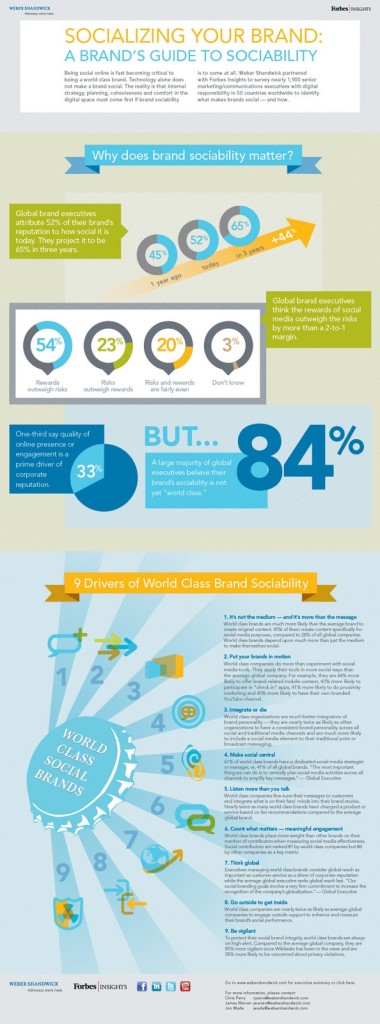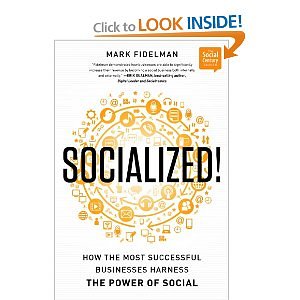
Credit: Social Business Today, 2011
Inspiration for this post came directly from Socialized!, the book by Mark Fidelman on what it takes to be a social business. Not 25 pages into the book, a section entitled “People Are More Loyal to Socially Engaged Businesses,” prompted this ponderance (yep, a word coin) about how well-known brands engage on Twitter.
I’m going to pick on Harry and David, the 80-year-old grower of Oregon pears that has become one of the seasonal faves for online shopping during holidays. I recently thanked them for their wonderful customer service, so I’m a promoter of their brand after being somewhat of a detractor recently.
In this section in Fidelman’s book in which he references a study by Constant Contact and research firm Chadwick Martin Bailey of 1491 consumers 18+ about brand engagement and loyalty on Twitter, he shared:
- “60 percent of brand followers are more likely to recommend a brand to a friend after following the brand on Twitter.
- 50 percent of brand followers are more likely to buy from that brand.
- 79 percent of those surveyed follow fewer than 10 brands, and a whopping 75 percent of Twitter users don’t follow brands at all. “
Fidelman’s interpretation of this data goes like this:
“Depending on how you interpret the data, that can mean either opportunity or difficulty: opportunity in the form of a rich open field of Twitter users who want to engage with your brand or difficulty if most Twitter users don’t want to hear from brands.”
Think about that a minute; I’ll wait.
Harry And David Twitter Stream
After writing a positive blog post about the brand Harry and David and then reading this section of Fidelman’s book, Socialized!, I decided to take a look at the Harry and David Twitter stream to see if that business was functioning as a social business, a social media business, or merely monitoring and being reactionary on Twitter.
Here’s what I found:
- From December 17, 2012 to January 7, 2013, there were 47 tweets in the Harry and David Twitter stream.
- Of those, 24 tweets were oriented to responses for negative customer experience.
- 12 of the tweets were positive comments to customers’ experiences.
- 6 tweets were neutral about customer experience.
- 5 tweets were actual outbound content relating to product, shipping, holiday deals.
Let’s do a bit of analysis about the Harry and David tweet stream relating to interpretation about being a social business or a socially engaged company:
With the volume of shipments flowing out of the Harry and David distribution centers during the holidays flying to all corners of the U.S. there are bound to be customer service and delivery snafus.
Of the 24 tweets oriented to negative customer service experience, some of the issues were about tardy delivery, frozen fruit, lack of sender identity. Why would consumers use Twitter to report and/or complain about these issues? The Twitter team can’t do anything about that but ask for an email notification so the issue can be routed to the appropriate department.
A tally of only 47 tweets doesn’t indicate that much traffic during this prime time period of holiday deliveries. What that means is the Twitter team (probably also managing Facebook), didn’t have to always be reactionary. The team could’ve scheduled tweets to post during all hours of the day and evening across time zones to share news about deliveries, products, best sellers, donations to charities, storm interference with deliveries, etc.
The stream had few company-generated posts oriented to marketing and sales messages or brand amplification. This was a lost opportunity for the social media team to really boost its presence on Twitter with more than just “sorry you had a negative experience.”
After reading and counting so many “sorry/negative” tweets to make this analysis, I waffled on whether the company had a poor holiday season OR this was par for the course and the company was happy with the 2012 holiday season. I wouldn’t know that, but hopefully the marketing director does.
Tips on Using Twitter For Business
- Remember that all content posted on Twitter stays in the stream. Anyone can read posts from past time periods. Mix up the content so it doesn’t sound the same!
- There should be approved corporate messages about the company, its products/services, its team, its events, hours of operation, etc. that are scheduled throughout the day on Twitter. These filler posts help keep the brand fresh.
- Analyze your company’s usage of Twitter; is it reactionary? Are you using Twitter to respond only to negative customer queries/comments? If so, ensure you mix up the content postings to balance the net promoter scores.
- When you’re an online retailer, like Harry and David, with food products, tweet all day long about your favorites and best sellers. Moose Tracks have got to be a best seller next to the pears! Share something about that alongside the good news about mouth-watering sweet pears, for example.
- If the social media team is tired and working to maintain the pace during holidays, be sure and switch out some people with a fresher perspective. The tweet stream needs to maintain a liveliness that keeps people’s attention.
Brands have a huge opportunity to make a difference on Twitter. Keep it fresh, post content about the company, respond to customers, and engage new customers, too.
As a final thought, companies are not social businesses yet; many have just now begun to feel comfortable engaging and building communities on a variety of channels. What’s next is to really look internally to see that all departments are playing together inside instead of functioning in traditional silos.






 Engaging on social media channels with customers and prospects does not a social business make. Being a social business requires this for starters, and more. Becoming social inside and out by engaging stakeholders at all levels takes consistent effort and clarity from the C-suite to the sales organization and elsewhere.
Engaging on social media channels with customers and prospects does not a social business make. Being a social business requires this for starters, and more. Becoming social inside and out by engaging stakeholders at all levels takes consistent effort and clarity from the C-suite to the sales organization and elsewhere.









